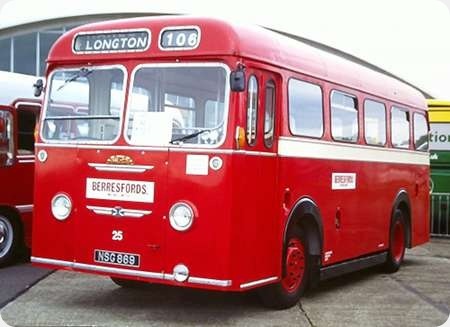Berresfords - Albion Nimbus - NSG 869 - 25
Berresfords Motors Limited
1955
Albion Nimbus MR9
Scottish Omnibuses B32F
NSG 869 is an Albion Nimbus, with MR9 designation. This vehicle has a Scottish Omnibuses B32F body, and in its early days was a demonstrator for the chassis builder Albion. It passed to that well-known Staffordshire independent, Berresfords Motors Limited of Cheddleton, in whose markings we see it at Duxford on 28 September 2003.
Photograph and Copy contributed by Pete Davies
05/05/16 - 06:58
The MR9 was the first version of the Nimbus, itself derived from the Claymore goods model, and it was available in two lengths as the MR9N (23ft 3ins by 8ft) and MR9L (24ft by 8ft). The chassis had Albion axles, the rear being driven by overhead worm, and the wheelbase was 11ft 10ins. The four cylinder 3.83 litre EN219 engine was basically two thirds of the Leyland O350, and it developed 60 bhp at 2200rpm. A four speed Albion gearbox was fitted. Certain features of the design were suspect, notably the poorly designed engine by-pass valve method of providing vacuum assistance for the braking system, and the type soon acquired a reputation for frailty, notably in the engine, engine mountings and gearbox departments. A total of 124 of the MR9 type was produced before Leyland in house cost cutting measures led to the appearance of the NS3 model, which had "bought in" standard BMC 5 ton truck range axles that limited the overall width of the vehicle to 7ft 6ins. The NS3 and later NS3AN proved to be just as unreliable as the MR9.
Roger Cox
05/05/16 - 10:57
Thank you, Roger. I have read somewhere that the amount of exhaust smoke these things produced meant they should have been named ‘Cumulo Nimbus’.
Pete Davies
06/05/16 - 06:50
…and this from the maker who used ‘Sure as the Sunrise’ as their slogan!
Stephen Allcroft
06/05/16 - 08:29
Delightful comment, Stephen!!!
Pete Davies
07/05/16 - 06:55
It’s strange how the heavyweight British bus manufacturers struggled to produce a successful small bus in the post-war era. The lightweight manufacturers seemed able to produce successful designs albeit mainly used for coach duties but the big boys never seemed to be able to scale down the likes of the Reliance and Tiger Cub to produce what we would now call a ‘midi-bus’ with any degrees of success. Probably Bristol were the most successful with the SU and then the LH. However I always find it difficult to judge the success or otherwise of Bristol products based on volume of sales as throughout the 1950’s and most of the 1960’s they had a captive market with the BTC/THC companies.
Philip Halstead
12/05/16 - 17:04
Philip.
Of course pre-war Leyland (Cub) Albion (Victor) and various
marques from Dennis Guy and Thornycroft all competed against the Bedford and came off worst, even
Ford stopped competing for a while (c1932-57). Just pre-war there were Kew Dodge and Opel Blitz
competitors, but they were selling on keen prices and immediate delivery, like Commer and Austin
post-war.
The Nimbus itself was inspired by Scottish Omnibuses building a Claymore-based 32
seat integral bus. Most of SBGs single decks were then 35-seat half cabs and all were crew operated.
This was at the same time Bristol and ECW were making the SC.
As for the SU it was only
introduced after Western and Southern National refused SC’s wanting something comparable to Devon
General’s Nimbii.
Why was the SU better than the Nimbus? I think it might have had better
engine mounting and it certainly benefitted from Bristol chassis well integrated with its ECW body.
Secondly nobody in the THC command economy would dare put an SU on a full-size route without good
reason. Finally they were confined to Western & Southern National with only a handful elsewhere and
so never got a hard life.
What we now call a midi-bus (e.g. the ADL E200) is rather bigger
than a pre-1962 Reliance or a Tiger Cub, although its seated passenger capacity may be less than an
OB.
The SC sat 35 in what were pre-1950 maximum box dimensions of 27’6" by 7’6" and
it was miraculously fuel efficient at the expense of levels of noise vibration and harshness that
would be unacceptable today providing marginal power that would be a hazard in modern dense traffic.
but again Crosville Lincolnshire and Eastern Counties mainly used them to move fresh air along empty
roads.
Stephen Allcroft
Quick links to the - Comments Page - Contact Page - Home Page

